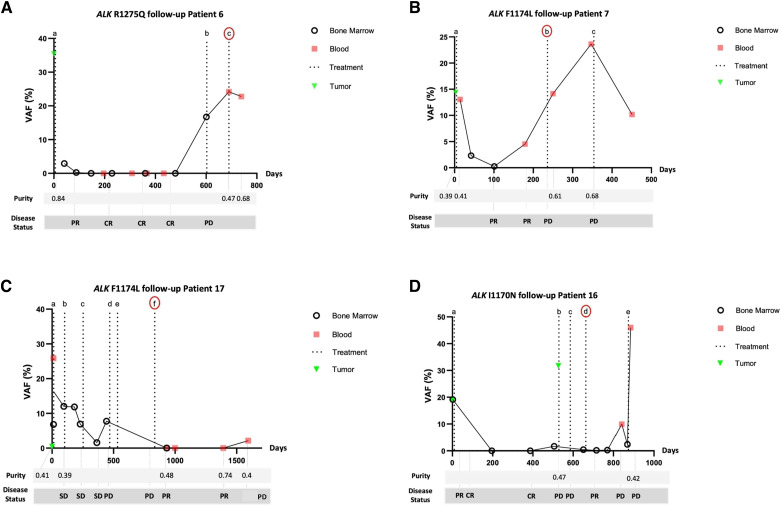Figure 3.
ALK hotspot mutations in cfDNA extracted from plasma samples of patients with neuroblastoma and comparison with disease status measured by ddPCR and WES. A, Patient 6 (5 years, INRG M, no MNA): ALK R1275Q VAFs (%; y-axis) by ddPCR analysis on WGS libraries of cfDNA extracted from sequential blood or bone marrow plasma. The number of days after diagnosis is represented in the x-axis. Treatments are indicated by letter: (a) HR-NBL 1.7, (b) Temodal, and (c) lorlatinib. Treatment according to HR-NBL1.7 was administered (a) with a decrease of ALK R1275Q VAF between D6, to 0% at D 41, D88, and D479, correlating with clinical complete remission. Upon relapse (D603) an increase of ALK R1275Q VAF to 17% was observed, corresponding to PD. Treatment with Temodal (b) resulted in further PD, with a further increase of ALK R1275Q VAF to 24%. After the start of lorlatinib (c), a small decrease of ALK R1275Q VAF to 22% at D739 was observed. The patient passed away due to PD. B, Patient 7 (14 years, INRG M, MNA): ALK F1174L VAFs (%; y-axis) by ddPCR analysis on WGS libraries of cfDNA extracted from sequential blood or bone marrow plasma. The number of days after diagnosis is represented in the x-axis. Treatments are indicated by letter: (a) HR-NBL 1.7, (b) lorlatinib, and (c) TOTEM. Initial treatment HR-NBL 1.7 (a) resulted in a decrease of ALK F1174L VAF from 13% at D5 to almost 0% at D101, correlating with clinical very good PR. On D179, ALK F1174L VAF increased to 4.5%, whereas imaging (CT scan, MIBG) concluded persistent VGPR. Relapse was confirmed at D222 (by local imaging and MIBG), indicating that ddPCR detected relapse 43 earlier than imaging. Lorlatinib (b) treatment was commenced D236 with a further increase of ALK F1174L VAF to 24%, with new PD on D349. TOTEM (c) commenced on D354 resulted in ALK F1174L VAF 10%, indicating clinically stable disease. The patient passed away due to PD. C, Patient 17 (10 years, INRG M, no MNA): ALK F1174L VAFs (%; y-axis) by ddPCR analysis on WGS libraries of cfDNA extracted from sequential blood or bone marrow plasma. The number of days after diagnosis is represented in the x-axis. Treatments are indicated by letter: (a) HR-NBL 1.7, (b) Beacon, (c) Pazopanib, (d) RT + Etoposide, (e) cyclophosphamide, (f) lorlatinib. ALK F1174L VAFs at D12 was 26% (blood) versus 7% (bone marrow). Induction of HR-NBL1 resulted in stable disease, with an ALK F1174L VAF persisting at 12% at D96. Beacon (b) commenced on D102 and resulted in SD, with ALK F1174L VAF 7% on D229. Pazopanib (c) treatment began on D253 with a temporary decrease of ALK F1174L VAF to 1.5% at D364 followed by a renewed increase to 7.755% at (D) lorlatinib (f) was commenced on D834, with ALK F1174L VAF subsequently attaining nearly 0%. A reemergence of ALK F1174L to 2% concomitant with a single MIBG lesion, preceding multimetastatic relapse. The patient passed away due to PD. D, Patient 16 (3 years, INRG M with no identified primary, no MNA) ALK I1170N VAFs (%; y-axis) by ddPCR analysis on WGS libraries of cfDNA extracted from sequential blood or bone marrow plasma. The number of days after diagnosis is represented in the x-axis. Treatments are indicated by letter: (a) HR-NBL 1.7, (b) Beacon, (c) CAdO, (d) lorlatinib, and (e) etoposide. ALK I1170N VAFs, at 19% at diagnosis decreased to 0% at D196 and D387 following HR-NBL 1.7 (a) treatment. At D506, ALK I1170N VAF increased to 2% with confirmation of PD by imaging on D514. ALK I1170N VAF was 0.4% at the beginning of lorlatinib treatment on D665 with a decrease to 0.169% at D716 and 0.260 at D770 but a new increase to ALK I1170N 10% on D840 coinciding with new PD. Salvage treatment proved inefficient, with ALK I1170N VAF at 45%. The patient passed away due to PD.

